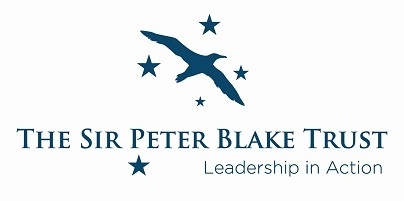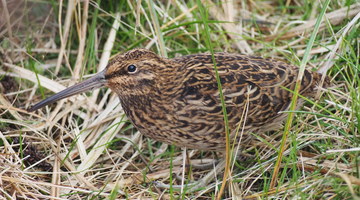An interactive overview of the Auckland Islands. Click on the labels for more information.
Select here to view the full transcript and copyright information.

Archaeological remains, including middens, suggest early Polynesians reached the Auckland Islands as early as the 13th century, but it wasn’t until 1806 that Europeans arrived at these wet, windy and wild islands. Positioned at 50° south, approximately 375 km south of Stewart Island on New Zealand’s continental shelf, the Auckland Islands are the largest of New Zealand’s Subantarctic Islands groups. Covering an area of 625 km2, the islands are the remains of two ancient volcanoes. Over millions of years, winds and waves have battered the western coast, forming tall, steep sea cliffs with a height of up to 400 m. The more sheltered eastern coast is characterised by a series of inlets formed when snow and ice covered the islands and erosive glaciers scoured out the basalt rocks.
The islands have a rich history that includes commercial sealing, numerous shipwrecks, wartime coast watching and attempted settlement. The most famous of these was the settlement of Hardwicke at Enderby Island. Established in 1849, it was soon abandoned in 1852 after the realisation that the soil, climate and lack of natural resources were not sufficient to support any substantial settlement.
Recently, the location of these islands in the middle of the Southern Ocean has been recognised as a critical point to study climate change, and scientists are increasingly visiting the islands to gain a better understanding of past climates.
The islands are home to a unique set of plants, invertebrates, birds and marine mammals. In 1993, a marine mammal sanctuary was established in the marine environment around the Auckland Islands. The islands were designated a UNESCO World Heritage Site in 1998 and the Motu Maha Marine Reserve in 2003. The Auckland Islands are currently managed by the Department of Conservation.
Explore the interactive to learn more about the history and unique ecology of the Auckland Islands. Click on a label for more information.
This interactive was adapted from resources produced by Nick Kingston from Birkenhead College who joined the Young Blake Expedition to the Subantarctic as the Sir Peter Blake Trust Educator in 2015. The original artwork is by Dave Gunson.
Transcript
Albatross
The Auckland Islands are home to a diverse group of seabirds including a variety of albatross species. The southern royal albatross (Diomedea epomophora), with a specially adapted wingspan of up to 3.5 m, is one of the largest. These birds spend most of their life at sea and will circumnavigate the globe before returning to land to breed.
Why have albatross evolved to have large wingspans?
Find out more about the toroa/albatross in this article.
Shipwrecks
Numerous sailing ships, taking advantage of the Southern Ocean’s westerly winds to transport their goods around the globe, have run aground on the rocky shoreline and reefs of the Auckland Islands. The General Grant was one such ship, and its wreck has eluded treasure hunters who have ventured to these islands in search of its legendary cargo of gold.
What challenges did the survivors of the shipwrecks face?
Acknowledgement: Public domain
Winds
Strong westerly winds of the roaring 40s and furious 50s latitudes mix atmospheric CO2 into the Southern Ocean where phytoplankton assimilate the carbon into their bodies. Dead phytoplankton sink, taking carbon to the deep ocean. This makes the Southern Ocean an enormous carbon reservoir. Recently, a southerly shift to the westerly wind belt has caused an increase in upwelling of carbon-rich deep water, releasing CO2 back to the atmosphere. The shifting wind has also caused a decrease in rainfall in southern New Zealand.
The Southern Ocean is part of a global system – the Global Ocean Conveyor. This is a system of deep currents that carry heat, salt and nutrients around the planet.
What impacts do you think this increased upwelling of carbon will have on the animal life in and around the Subantarctic Islands? What impacts might it have on climate around the Subantarctic Islands, New Zealand and the world?
Acknowledgement: Sir Peter Blake Trust.
Southern right whales
Southern right whales (Eubalaena australis) were once common in New Zealand’s waters but came close to extinction after intense hunting. There is still a small population of the whales that visit Port Ross in the Auckland Islands each winter to breed and calve. New Zealand’s southern right whale numbers are slowly recovering, but despite their increasing numbers, the genetic diversity of the population remains low.
Southern right whales are genetically differentiated based on philopatry to their calving grounds (Australia, New Zealand, South Africa or Argentina) but are still considered the same species.
What are the issues associated with a lack of genetic diversity in a species?
Acknowledgement: Sir Peter Blake Trust.
Geology
During cold periods of Earth’s history, glaciers carved channels into the volcanic rocks from which the islands were originally formed. As the Earth warmed and sea level rose, these channels became the long, deep, steep-sided inlets that now line the eastern coast of Auckland Island.
Glaciers are not landforms. It is the action of glaciers that creates landforms. The process is known as glaciation.
How might evidence for glaciation around the globe also provide evidence for the movement of the continents?
Acknowledgement: University of Waikato
Commercial hunting
Commercial hunting decimated New Zealand’s seal and sea lion populations during the early 19th century. Although New Zealand sea lions were once common throughout all of New Zealand, the Auckland Islands are now the main breeding ground for these rare animals.
Great white sharks are known predators of New Zealand sea lions, and a number of adult sea lions have scars that appear to be the result of close encounters with great white sharks. It is likely that other causes such as disease and the impact of squid fishing have resulted in the dramatic decline in sea lion numbers in the last 10–12 years.
What measures might further help the New Zealand sea lion population to recover?
Acknowledgement: Men with clubbed seals, Campbell Island. Judd, Norman: Photographs of Southern Islands; glass negs, photographs, postcards, all of Campbell Island; print of old hut, print of albatrosses. Ref: 1/2-100388-G. Alexander Turnbull Library, Wellington, New Zealand. http://natlib.govt.nz/records/23130231
Huts
Because of regular shipwrecks and marooned sailors, castaway huts with food provisions were set up at points around the islands. The maintenance of these huts was abandoned by the New Zealand Government in 1923.
During World War II, the New Zealand Government was concerned that enemy ships might use the islands. Prefabricated huts were shipped to Auckland Island in 1941 and erected at Port Ross in the north and Carnley Harbour at the south end of the island. These were used as lookouts.
Acknowledgement: Dougall, William, b 1845. Hut on Campbell Island with three unidentified men. Judd, Norman: Photographs of Southern Islands; glass negs, photographs, postcards, all of Campbell Island; print of old hut, print of albatrosses. Ref: 1/2-117141-F. Alexander Turnbull Library, Wellington, New Zealand. http://natlib.govt.nz/records/22729718.
Southern rātā
New Zealand’s southern-most forest tree, the southern rātā (Metrosideros umbellata), extends across the shoreline of the Auckland Islands. The bright red flowers that bloom in late summer provide nectar to many small birds such as tūī and bellbird.
What differences might you expect to see between southern rātā and northern rātā?
Acknowledgement: Craig McKenzie, licensed under Creative Commons 2.0.
Introduced mammals
Pigs and other mammals were introduced to Auckland and Enderby Islands as a food source for marooned sailors. Enderby has been cleared of all pests, but pigs, cats and mice still remain on Auckland Island. These destructive animals have decimated native plant and animal species, and the Department of Conservation is now investigating how to eradicate the remaining pigs from the island.
Due to their long isolation, Auckland Island pigs have become the only disease-free pigs on the planet, which makes them suitable for use in the treatment of diseases such as diabetes through pig-human transplants.
Is there a case for protecting the disease-free pigs on Auckland Island?
Acknowledgement: Stephen Horn/Department of Conservation.
Endemic species
Remote island communities often have a unique ecology and high proportion of endemic species. Plants and animals isolated for long periods of time evolve to suit their local environment.
The Auckland Island snipe, a small ground-dwelling bird, is a subspecies endemic to the Auckland Islands. Other Subantarctic Islands have their own endemic form of these birds. Pictured is the Campbell Island snipe.
Can you think of other islands around Australasia and the world that have a high proportion of endemic species? What are the factors that influence the evolution of endemic species?
Acknowledgement: Mary-Anne Lea/NZ Birds Online.
Megaherbs
Known collectively as megaherbs, plants with unusually large leaves and flowers, such as the Campbell Island daisy (Pleurophyllum speciosum), are a characteristic of Subantarctic Islands flora. It is thought that these unusual features may confer a thermal benefit in cold, cloudy conditions.
Have a go at classifying megaherbs, using image cards to group species according to their physical structures.
Acknowledgement: Twiddleblatt, licensed under Creative Commons 2.0.
Penguins
The eastern rockhopper penguin (Eudyptes filholi) is one of three species of penguins that can be found on the Auckland Islands. The rare yellow-eyed penguin (Megadyptes antipodes) also comes ashore here to breed. The Department of Conservation carry out an annual yellow-eyed penguin survey on the Auckland Islands.
Some erect-crested penguin (Eudyptes sclateri) can be found on the islands, but scientists think it is unlikely they breed there any more as an egg has not been seen since 1972. It is likely that the ornate crest feathers are involved in sexual selection. Crests may also indicate general health, social status and sexual maturity as the crests do not form until the first annual moult and do not reach their full length and brightness until the second or third year.
Pictured is the erect-crested penguin.
What other bird adaptations for sexual selection can you think of?
Yellow-eyed penguins are our rarest species of penguin. What are some of the possible factors causing the population to decline? What is being done to stop New Zealand from losing another endemic species?
Acknowledgement: Colin Miskelly, Birds Online.
Acknowledgement
This interactive was adapted from resources produced by Nick Kingston from Birkenhead College, who joined the Young Blake Expedition to the Subantarctic as the Sir Peter Blake Trust Educator in February 2015.
Useful links
Find out more about Pests and threats on New Zealand's subantarctic islands from the Department of Conservation.
Learn more about the history of early human habitation and the disastrous Enderby settlement on the Subantarctic Islands, from Te Ara, the Online Encyclopedia of New Zealand.



